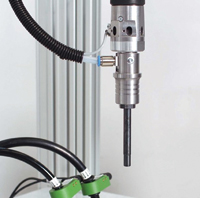
Posted to News on 21st Nov 2017, 00:00
Ensuring technical cleanliness in screw assembly processes
How do you prevent particle contamination in sensitive assembly processes? Robert Bachmeier of Deprag offers some advice.

Just as an aggressive virus can cause illness in humans, the smallest particles can damage components and lead to malfunctions or, if used as system components, could even lead to a complete system failure. There are many reasons that such hazardous particles may be generated during production processes. In the automotive industry, for example, particles are predominantly created by abrasion during assembly.
Technical cleanliness is increasingly being introduced in a wide range of sectors and is becoming an important quality requirement for the whole process chain. The trend toward miniaturisation, as well as increased electronics and the greater use of new lightweight materials is primarily responsible for this. On the one hand, components are more powerful and efficient but on the other hand, they are also sensitive to even the slightest impurities.
An example of the consequences of miniaturisation can be seen in injection systems. These must withstand increasing pressures and, already small, they are becoming smaller and smaller in size, in places only a few micrometres. Micrometre sized, hard, metallic particles can block gaps causing continuous injection. This can affect the function of a motor enormously and lead to motor damage. In electronic components, even the smallest conductive particles can cause a short circuit. These problems are amplified by the use of new materials such as carbon-fibre reinforced plastics (CFRP) whose particles are conductive.
There is a wide range of techniques and methods which can be employed to fulfil the increasing requirements for technical cleanliness in production processes. For example, processing steps involving components which are sensitive to cleanliness are relocated to cleanrooms and entry is only permitted to trained personnel wearing appropriate protective clothing. This should avoid any infiltration of particles from the outside. In addition, components undergo extensive cleaning procedures and creation of particles from abrasion during transportation is prevented by using fixed position and anti-static packaging.
The effort involved in the prevention of particle contamination should be rigorously and continuously maintained throughout assembly because it is here, in direct contact with components, that hazardous particles can be generated through abrasion. The risk is high that sensitive components may become contaminated by dangerous particles. The percentage of such components is high within the automotive and supplier industries where there is an increasingly tight focus on technical cleanliness during the assembly process.
The assembly working area may need to be designed as a cleanroom depending on the component and its cleanliness requirements. An essential role is played by the components of the assembly system as hazardous dirt particles may first be generated during part feeding and the actual screwdriving process. Action must be taken to avoid, combat or reduce particle contamination to sensitive components and modules during these assembly steps.
Deprag Schulz has developed a universal concept to meet these challenges: the CleanFeed concept. It is based on the company’s specifically designed CleanFeed components. The spectrum includes suitable feeding technology and appropriate screwdriving function modules through to equipment for the suction and extraction of dirt particles generated during assembly. The concept fulfils the requirements of technical cleanliness, avoiding, eliminating and reducing particles throughout the complete screwdriving assembly process.
Undesirable particles may also arise during screw separation. When using a vibratory spiral bowl feeder, for example, the connection elements are moved up the spiral path by pulsing vibrations. This constant vibration can cause parts to rub against each other and create abrasive contaminants, which are then transported into the feed system by the feed parts. Therefore, if there are high cleanliness requirements, a component friendly low abrasion feeding technology is an important prerequisite for technical cleanliness in assembly.
The Deprag CleanFeed concept sword feeder’s segment shaped sword arm lifts screws out of their supply hopper using a stroke movement generating hardly any friction. A sensor in the supply rail regulates the number of stroke movements required. If fewer parts are being used by the operator, then the feeder will supply fewer parts. The screws slide along the mechanical rails using gravity and are already sorted by the time they reach the screw separator. A feed hose is then used to transport the connection elements to the screwdriving module. Incorrectly positioned elements are returned to the hopper.
Abrasion can however also be generated in the feed hose, primarily at the bends but also when tumbling through straight parts of the hose. Deprag has a solution for this as well: the particle killer – a low-cost efficient vacuum source which captures and extracts residual dirt particles. As well as the inline version, which shoots the cleaned connection elements directly into the mouthpiece of the screw tool, there is also have a pick and place version available which carries out suction cleaning at the pick-up position.
Unit B4, Pegasus Court
Ardglen Industrial Estate
RG28 7BP
UNITED KINGDOM
+44 (0)1256 895074







